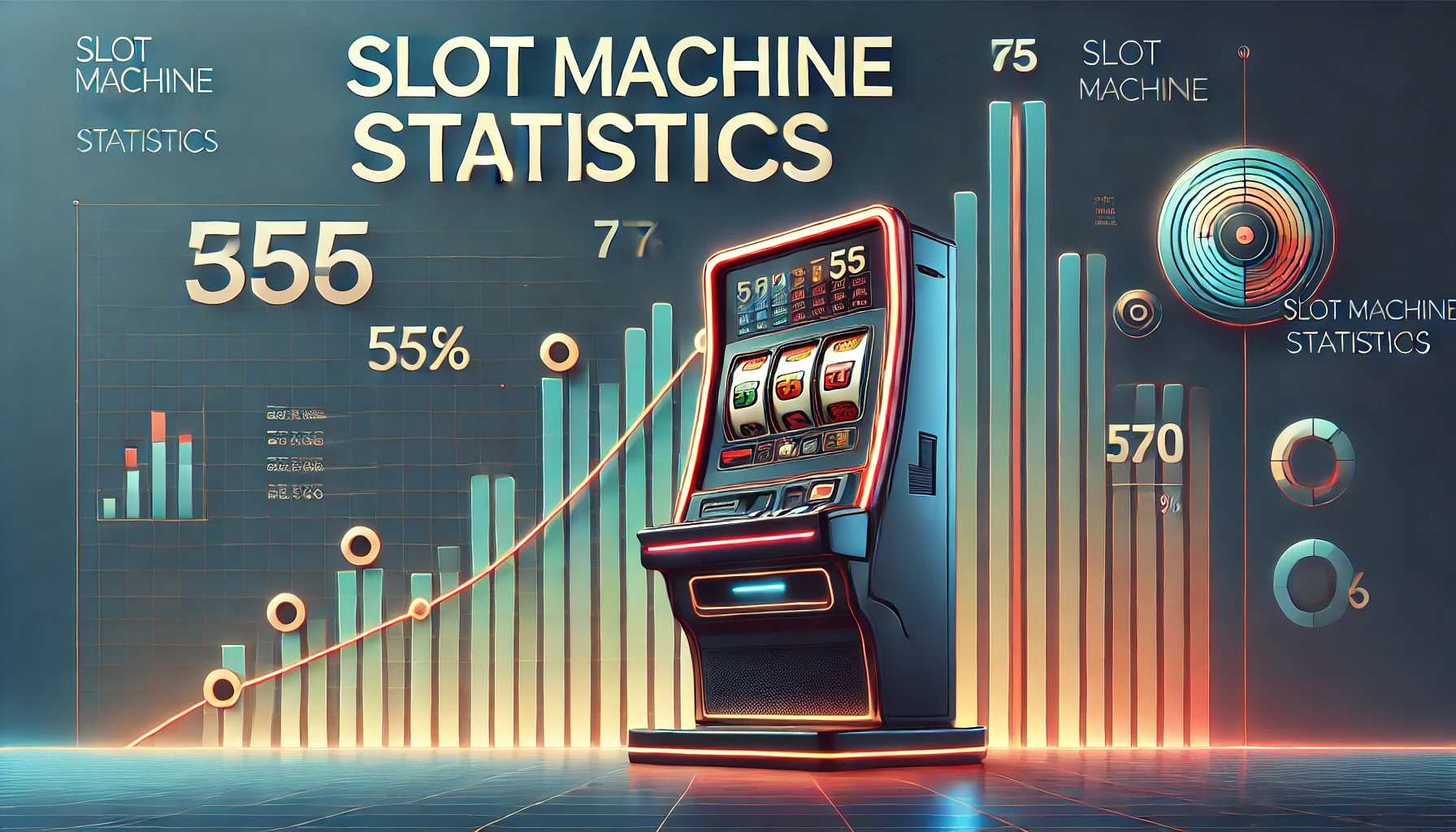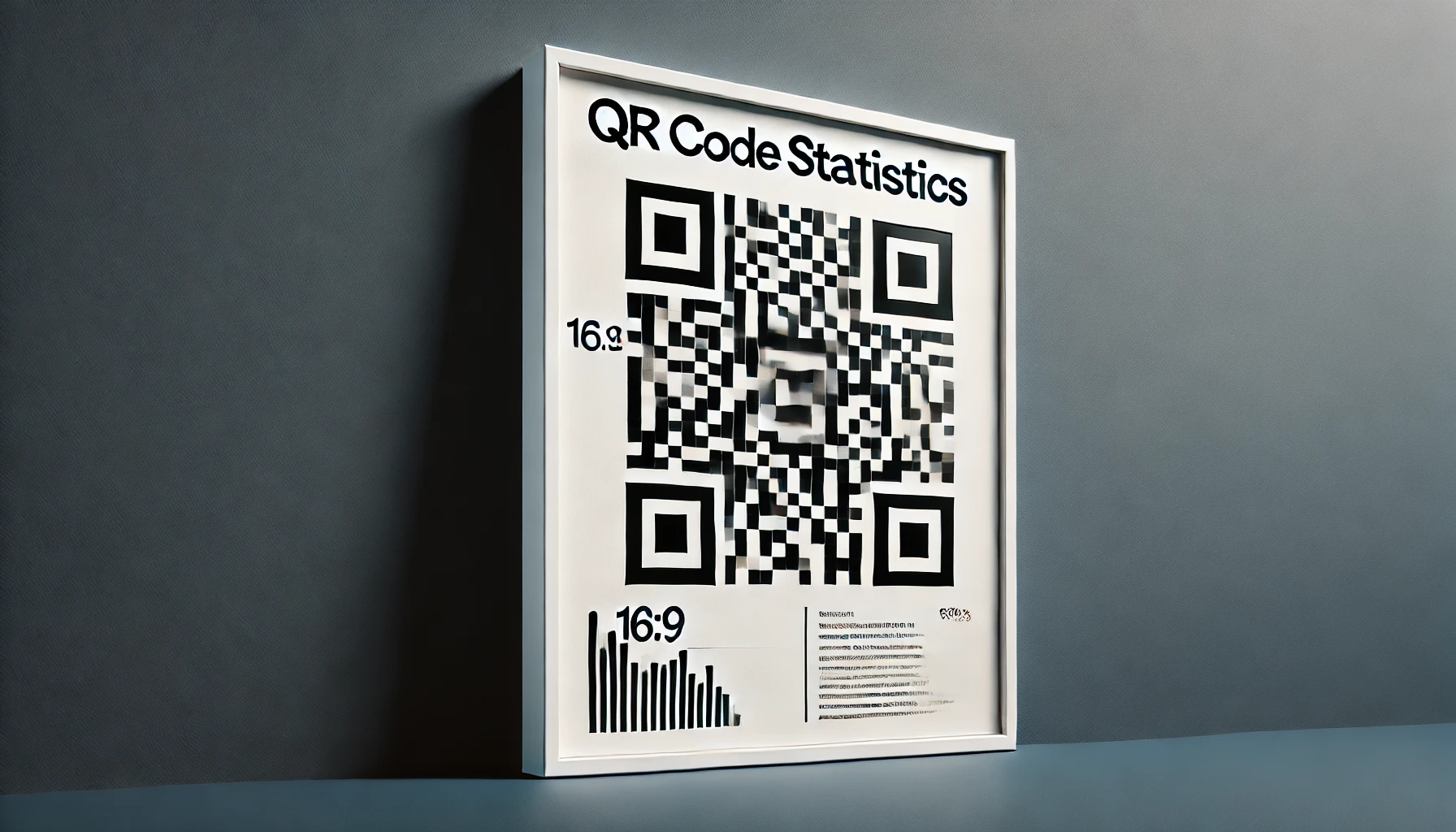Freelance Statistics By Skills, Wages, Jobs, Trends, Region, Impact And Demographic
Updated · Sep 19, 2024

WHAT WE HAVE ON THIS PAGE
- Introduction
- Editor’s Choice
- What is A Freelancer?
- Freelancer And Taxes
- General Freelance Statistics
- Top 10 Freelancing Skills Needed In The Technical FieldTop Of Form
- Top 10 Advertising Skills For 2024
- Top 10 Most Valuable Freelance Customer Service Skills
- Top In-Demand Freelance Marketing Skills Statistics
- Freelancer Wages Statistics
- Popular Freelance Job
- Freelancing Trends For 2024
- Freelance Regional Statistics
- Number Of Freelancers
- Impact Of COVID-19 On Freelance Work
- Freelancer Statistics For Business And Economy
- Freelancing Demographics Statistics
- Freelance Platform Statistics
- Conclusion
Introduction
Freelance Statistics: With the internet and digital tech changing how we work, you don’t have to stick to a 9-to-5 office job anymore. Some people think freelancing is the best way to work today, while others see it as just a temporary trend. To figure out which is true, look at some straightforward Freelance Statistics.
These numbers will give you clear information about freelancing, whether you want to hire a contractor at a lower cost or are thinking about a career change.
Editor’s Choice
- In the United States, 70% of small and medium-sized businesses hire freelancers at least sometimes.
- 61% of freelancers say they choose to work this way voluntarily.
- Freelance Statistics stated that around half of all freelancers have advanced degrees.
- For 51% of workers, working from home has boosted their productivity.
- Singapore, New Zealand, Spain, Australia, and Denmark are the top five countries where freelancers like to live.
- Most freelancers work between 30 and 50 hours per week.
- There are 1.57 billion freelancers worldwide, making up 47% of all workers globally.
- The US currently has 73.3 million freelancers, and this number is expected to rise to 76.4 million by the end of the year.
- The percentage of self-employed people has fallen from 55.5% in 2000 to 46.6% in 2024.
- Freelancers in the US make an average of $47.71 per hour.
- Full-time freelancers generally work 43 hours a week, as per Freelance Statistics.
- 54% of freelancers work five days a week.
- The market for freelance platforms is expected to grow to $9,570.3 million by the end of 2030.
- Working from home can improve performance by up to 13%.
- The top freelance skills in demand are Instagram marketing, brand strategy, and AI development.
- The average hourly rate for freelancers around the world is $19/hour.
- 31% of freelancers earn more than $75,000 a year.
- 84% of freelancers feel that freelancing lets them live the lifestyle they desire.
- Freelance Statistics stated that around 67% of freelancers think that freelance pay should keep increasing.
- 48% believe that freelancing is a long-term career option.
What is A Freelancer?
A freelancer earns money for each job they do, usually working on short-term projects as an independent contractor. They’re not employed by one company, so they can take on work from different clients at the same time unless they’ve agreed to focus on just one project until it’s finished. Freelancers are an important part of the gig economy.
Freelancer And Taxes
- The IRS considers freelancers as self-employed workers. Unlike regular employees, freelancers don’t have taxes automatically deducted by an employer. They are responsible for paying their income taxes.
- Freelancers need to pay estimated taxes in advance, usually every three months.
- Besides income tax, they also have to pay self-employment tax, which includes Social Security and Medicare taxes.
- Instead of getting a W-2 form, freelancers receive a 1099-NEC form from each client, which typically doesn’t have any taxes withheld.
Self-Employment Tax:
- Social Security Tax: Freelancers pay 12.4% total (6.2% as both the employee and the employer). For 2024, this tax only applies to the first $168,600 of earnings.
- Medicare Tax: Freelancers pay a total of 2.9% (1.45% as both the employee and the employer). There’s no limit on Medicare tax, but if you earn above certain amounts ($250,000 for married couples filing jointly, $125,000 for married couples filing separately, and $200,000 for others), you’ll pay an extra 0.9% Medicare tax.
- Freelancers who earn $400 or more in a year must pay self-employment tax.
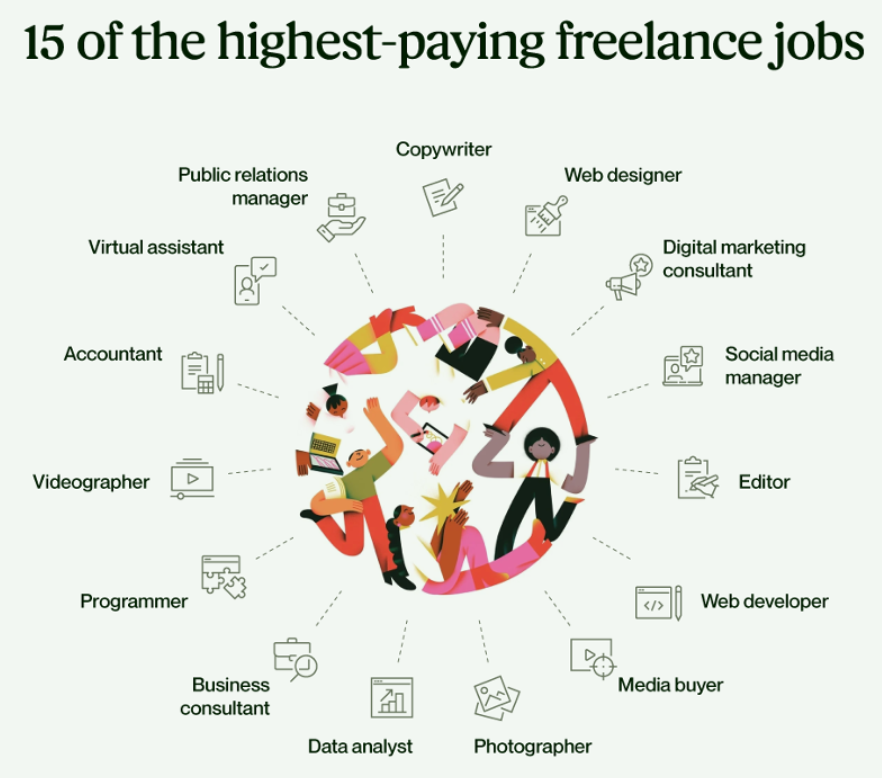
(Source: carminemastropierro.com)
- Freelancers can lower their taxable income by deducting certain business expenses. These must be necessary and related to the business.
- Deductible expenses include home office costs, job-related travel, client entertainment, and professional courses or certifications.
General Freelance Statistics
- In 2023, there will be 73.3 million freelancers in the US, up from 70.4 million in 2022 and 67.4 million in 2021.
- The number of freelancers is expected to grow to 76.4 million by 2024, as per Freelance Statistics.
- By 2028, it’s forecasted that 90.1 million people will be freelancing in the US.
| Year | Number of Freelancers in the United States |
|
2028 |
90.1 million |
| 2027 |
86.5 million |
|
2026 |
83 million |
| 2025 |
79.6 million |
|
2024 |
76.4 million |
| 2023 |
73.3 million |
|
2022 |
70.4 million |
| 2021 |
67.4 million |
|
2020 |
64.8 million |
| 2019 |
62.2 million |
|
2018 |
59.7 million |
| 2017 |
57.3 million |
- Freelancing is growing in popularity because it offers flexible work options.
- Many freelance jobs can be done from home, avoiding traditional work issues like dress codes, commuting, and fixed 9-to-5 hours.
- In the US, freelancers earn an average of $68,947 per year or about $33 per hour.
- Their yearly earnings range from $15,000 to $158,000. According to Freelance Statistics, freelancers in North America usually make more due to the higher cost of living.
- In 2023, about 46.5% of workers worldwide were self-employed.
- The rise of the digital economy makes it easier to work from anywhere, reducing reliance on local job markets.
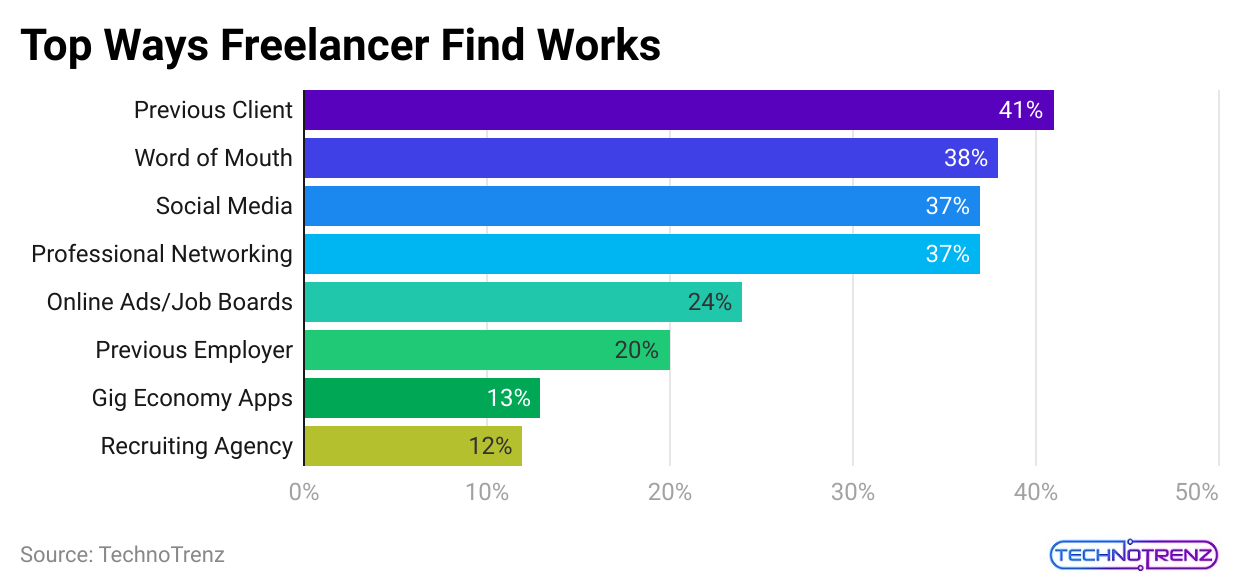
(Reference: websiteplanet.com)
- In low-income countries, 80.3% of workers are self-employed, while only 12.2% in high-income countries are.
- Professor Gary Fields from Cornell University notes that people in poorer countries often start their businesses because there aren’t enough job opportunities.
- Freelance Statistics stated that the US is the top freelancing country with the highest revenue growth of 78%.
- Freelancers with the right skills and platforms can earn well, especially in areas like programming, marketing, business consulting, and writing.
- The UK and Brazil also have significant earnings growth, with increases of 59% and 48%, respectively.
- Freelance Statistics stated that almost 48% of Gen Z workers are freelancers.
- 67% of Gen Z are either freelancing or planning to start. According to Fiverr via Yahoo! Finance, 20% of them are motivated by dissatisfaction with their full-time jobs.
Many Gen Z workers believe a college degree or a 9-to-5 job isn’t needed for success:
- 40% think a degree is optional for a successful career.
- 70% view freelancing as a good alternative to traditional 9-to-5 jobs.
- 24% believe taking a gap year to explore interests or travel is important before starting a career.
- Many Gen Z freelancers think independent work is more stable than traditional jobs, reducing their fear of layoffs.
- 86% of freelancers work from home.
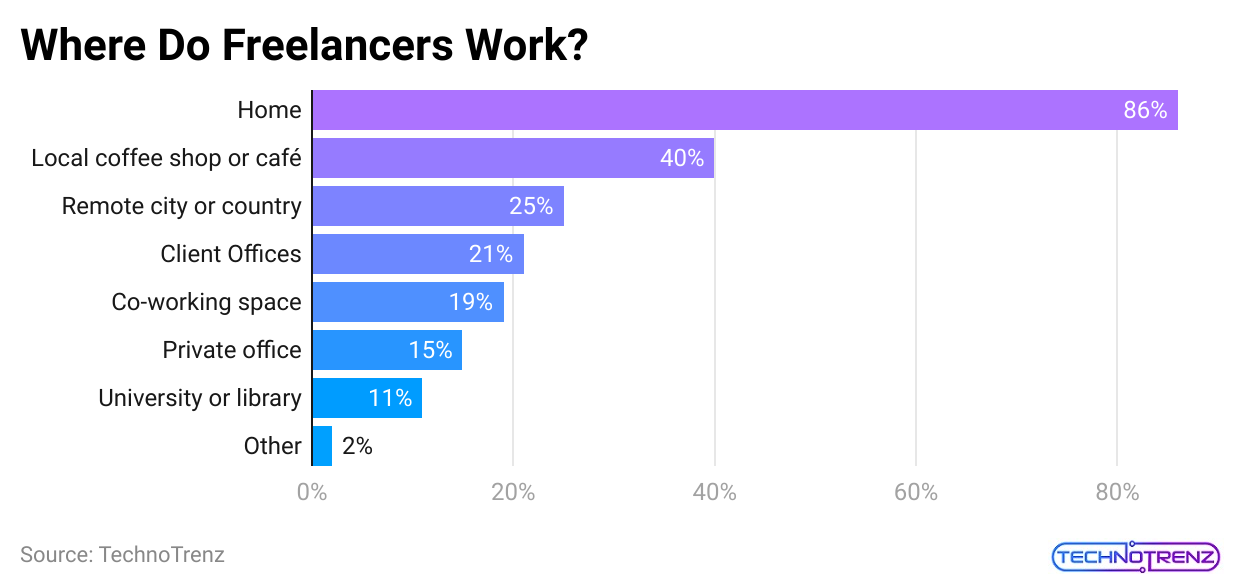 (Reference: websiteplanet.com)
(Reference: websiteplanet.com)
- Working from home is appealing because it avoids commuting, dress codes, and fixed hours. However, it can also have downsides like noisy environments, construction, and poor internet.
- To stay productive, many freelancers choose coffee shops, co-working spaces, or client offices.
- Gig workers make about 40% less per hour than the minimum wage.
- Many freelancers are satisfied with their earnings but need to work longer hours to reach their financial goals.
- 62% of gig workers lose money due to technical issues with clocking in or out.
- 19% have faced hunger because they couldn’t afford food.
- Freelance Statistics stated that roughly 31% have struggled to pay utility bills.
- Many gig workers still need help with economic insecurity despite the promise of flexible work.
- 74% of freelancers say clients don’t pay on time.
- Most freelancers wait at least two months for payment, even if they set a payment date.
- 20% are paid within 24 hours, while 16% wait two months or more.
- Freelance Statistics stated that around 72% of freelancers have unpaid invoices, often totaling $50,000 or more.
- Male freelancers are 350% more likely to earn over $150,000 per year compared to female freelancers.
- Despite this pay gap, women freelancers are more likely to get paid.
- 62% of female freelancers report that clients don’t disappear, while nearly half of male freelancers experience this problem.
Top 10 Freelancing Skills Needed In The Technical FieldTop Of Form
- Applications Program Interface (API)
- Website Development
- Hypertext Preprocessor (PHP).
- Hypertext Markup Language (HTML)
- Cascading Style Sheets (CSS)
- Java Script
- Web Programming
- WordPress
- Web Design
- Java Script
Top 10 Advertising Skills For 2024
- Marketing Automation
- Marketing Strategy
- Email Marketing
- Search Engine Marketing
- Telemarketing
- Sales and Business Development
- Lead Generation
- Other Digital Marketing
- Social Media Marketing
- SEO
Top 10 Most Valuable Freelance Customer Service Skills
- Administrative Support
- Data entry
- Answering product questions
- Online chat support
- Communication etiquettes
- Phone support
- Email support
- Email communication
- Customer support
Top In-Demand Freelance Marketing Skills Statistics
- Marketing research
- Email marketing
- Social media Management
- Marketing strategy
- Instagram marketing
- Business-2-Business marketing
- Search Engine Optimization (SEO)
- Lead Generation
- Social Media Marketing
Freelancer Wages Statistics
- Freelance Statistics stated that almost 48% of Gen Z workers are freelancers.
- 67% of Gen Z are either freelancing or planning to start. According to Fiverr via Yahoo! Finance, 20% of them are motivated by dissatisfaction with their full-time jobs.
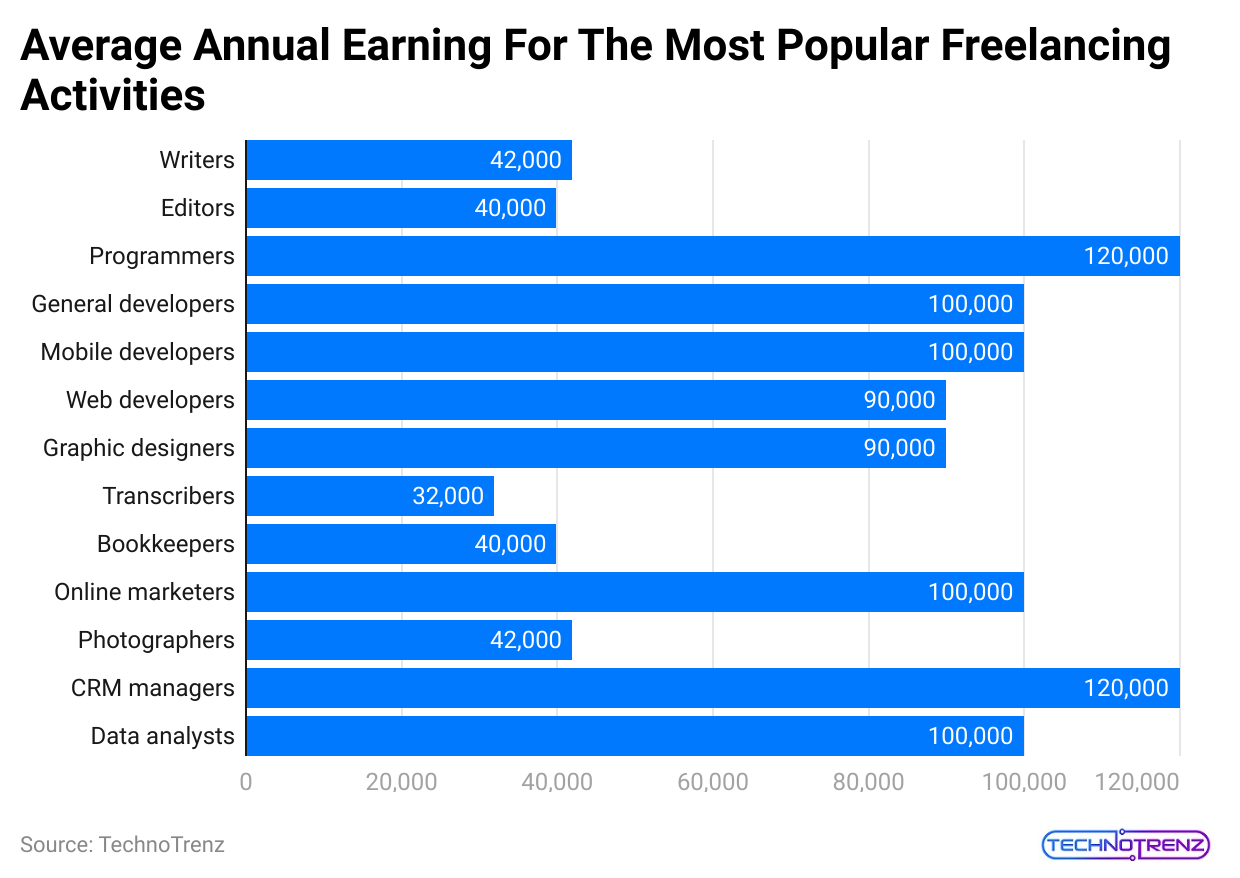
(Reference: explodingtopics.com)
- In the US, programmers earn the highest average pay, making $60 to $70 per hour, which adds up to about $120,000 a year.
- Data analysts and mobile developers make $55 to $65 per hour, with annual earnings of around $100,000.
| Freelancer Job Title | Hourly Wage | Annual Salary |
| Data analysts | $55-65/hr | $100,000 |
|
CRM managers |
$50-60/hr | $120,000 |
| Photographers | $35-45/hr |
$42,000 |
|
Online marketers |
$50/hr | $100,000 |
| Bookkeepers | $30-35/hr |
$40,000 |
|
Transcribers |
$20-25/hr | $32,000 |
| Graphic designers | $40-45/hr |
$90,000 |
|
Web developers |
$50-60/hr | $90,000 |
| Mobile developers | $55-65/hr |
$100,000 |
|
General developers |
$50-60/hr | $100,000 |
| Programmers | $60-70/hr |
$120,000 |
|
Editors |
$25-35/hr | $40,000 |
| Writers | $30-40/hr |
$42,000 |
Many Gen Z workers believe a college degree or a 9-to-5 job isn’t needed for success:
- 40% think a degree is optional for a successful career.
- 70% view freelancing as a good alternative to traditional 9-to-5 jobs.
- 24% believe taking a gap year to explore interests or travel is important before starting a career.
- Many Gen Z freelancers think independent work is more stable than traditional jobs, reducing their fear of layoffs.
- 86% of freelancers work from home. This is appealing because it avoids commuting, dress codes, and fixed hours.
- However, it can also have downsides like noisy environments, construction, and poor internet.
- To stay productive, many freelancers choose coffee shops, co-working spaces, or client offices.
- Freelance Statistics stated that Gig workers make about 40% less per hour than the minimum wage.
- Many freelancers are satisfied with their earnings but need to work longer hours to reach their financial goals.
- 62% of gig workers lose money due to technical issues with clocking in or out.
- 19% have faced hunger because they couldn’t afford food.
- 31% have struggled to pay utility bills.
- Many gig workers still need help with economic insecurity despite the promise of flexible work.
- Freelance Statistics stated that almost 74% of freelancers say clients don’t pay on time.
- Most freelancers wait at least two months for payment, even if they set a payment date. Twenty percent are paid within 24 hours, while 16 percent wait for two months or more.
- 72% of freelancers have unpaid invoices, often totaling $50,000 or more.
- Male freelancers are 350% more likely to earn over $150,000 per year compared to female freelancers.
- Despite this pay gap, women freelancers are more likely to get paid.
- 62% of female freelancers report that clients don’t disappear, while nearly half of male freelancers experience this problem.
Popular Freelance Job
Freelancing has often been associated with artists and creative professionals, but the need for freelancers is growing in many areas. Here’s a look at the freelancing scene in 2023:
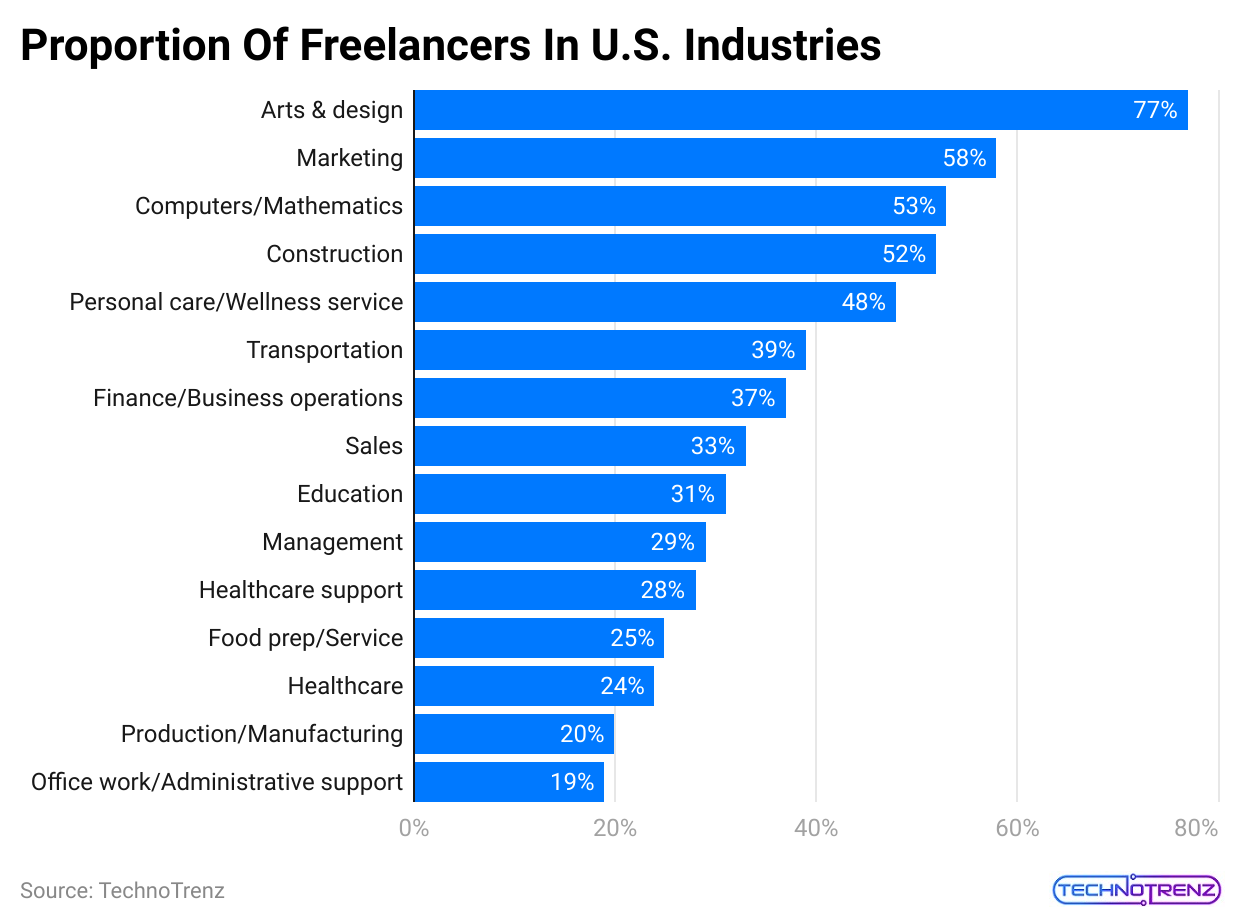
(Reference: explodingtopics.com)
- Content Creation: This field is very popular. On Upwork, graphic designers can earn up to $150 per hour on average, which makes it more profitable than working as a regular content writer.
- Creative Sector: Most freelancers in the US work in creative jobs. For instance, 75% of people working in art and design are freelancers.
- Entertainment and Construction: Freelancing is also common in other industries. In the entertainment field, 55% of workers are freelancers, and the same goes for the construction industry.
- In-Demand Skills: Web design is one of the top 15 most sought-after skills for freelancers on Upwork. SEO consulting is also a great option for long-term success, with the potential to start your SEO agency and explore other opportunities.
- High-Paying Freelance Jobs: Some of the highest-paying freelance roles include SEO consulting, ad management, direct response copywriting, software development, and sales and lead generation.
- Popular Skills: Freelancers highly demand skills like Instagram marketing, brand strategy, and AI development. Bottom of Form
Freelancing Trends For 2024
- As we enter 2024, the trends from 2023 clearly show that the freelance market will continue growing.
- With the rise of AI, there’s more demand for specialists like prompt engineers, machine learning experts, and data scientists.
- Freelancers focusing on data analysis, data science, and machine learning are expected to be in high demand, with 14.2%, 11.2%, and 10.3% of freelancers concentrating on these areas, respectively.
- Knowing programming languages like Python, Java, and SQL will also be crucial.
- About 20% of freelancers are looking forward to working just four days a week or even less.
- Many believe that working fewer days will help them be more efficient and still reach their earnings goals. Moreover, 96.5% of freelancers want more personal time, and 88.9% would like to spend more time with their families.
- LinkedIn USA reports that employers are now placing more value on soft skills such as communication and teamwork rather than hard skills.
- 73% of freelancers, strong communication skills are the most important for success, according to freelance statistics.
- The following table offers more details on the essential soft skills for freelancers.
| Soft skills for freelancers | Share of freelancers that consider them most important. |
| Creativity | 27% |
|
Emotional intelligence |
31% |
| Perseverance |
40% |
|
Self-confidence |
46% |
| Flexibility |
53% |
|
Discipline |
53% |
| Willingness to learn |
55% |
|
Self-motivation |
55% |
| Problem-Solving |
62% |
|
Communication |
73% |
| Others |
2% |
- Freelancers in their 30s and older will begin to focus more on saving and planning for retirement.
- Many freelancers in the US currently need to prepare for retirement and savings. To help with this, the government is introducing new laws like Secure 2.0, which will offer savings match programs starting after 2027.
- Because of this, freelancers in their 30s are expected to start saving about 15% of their income each month.
Freelance Regional Statistics
- About 1.57 billion people are self-employed worldwide.
- This makes up nearly half of the global workforce or around 46.6%.
| Rank | Country | Self-Employment % |
| 10> | Madagascar | Madagascar |
| 9 | Benin |
88.1% |
|
8 |
Equatorial Guinea | 88.4% |
| 7 | Sierra Leone |
90.3% |
|
6 |
South Sudan | 91.6% |
| 5 | Somalia |
91.7% |
|
4 |
Guinea | 91.9% |
| 3 | Chad |
92.6% |
|
2 |
Central African Republic | 93.2% |
| 1 | Niger |
95.1% |
All of the top 10 countries with the highest percentage of self-employed workers are in Africa. In fact, only two of the top 25 are not African:
- 11th: North Korea (87.2% self-employed)
- 18th: Afghanistan (82.2% self-employed)
- Below are the top countries by the percentage of self-employed workers for various regions:
| Region | Regional Average | Highest-Ranked Country (Rank) | Self-Employment |
| North America | 7.1% | Canada (142) |
15.2% |
|
European Union |
15.2% | Greece (100) | 31.9% |
| Middle-East and North Africa | 29.7% | Afghanistan (18) |
82.2% |
|
Latin America and the Caribbean |
38.2% | Haiti (33) | 73.5% |
| East Asia and the Pacific | 43.5% | North Korea (11) |
87.2% |
|
South Asia |
71.6% | Nepal (26) | 77.3% |
| Sub-Saharan Africa | 75.2% | Niger (1) |
95.1% |
- On the other hand, the countries with the smallest percentages of self-employed workers are:
| Rank | Country | Region | Self-Employment |
| 182 | Qatar | Middle-East |
0.4% |
|
181 |
Kuwait | Middle-East | 1.8% |
| 180 | Bahrain | Middle-East |
2.7% |
|
179 |
Oman | Middle-East | 3.7% |
| 178 | Belarus | Eastern Europe |
4.3% |
- In low-income countries, about 80% of people are self-employed, while in high-income countries, only around 12.4% are self-employed.
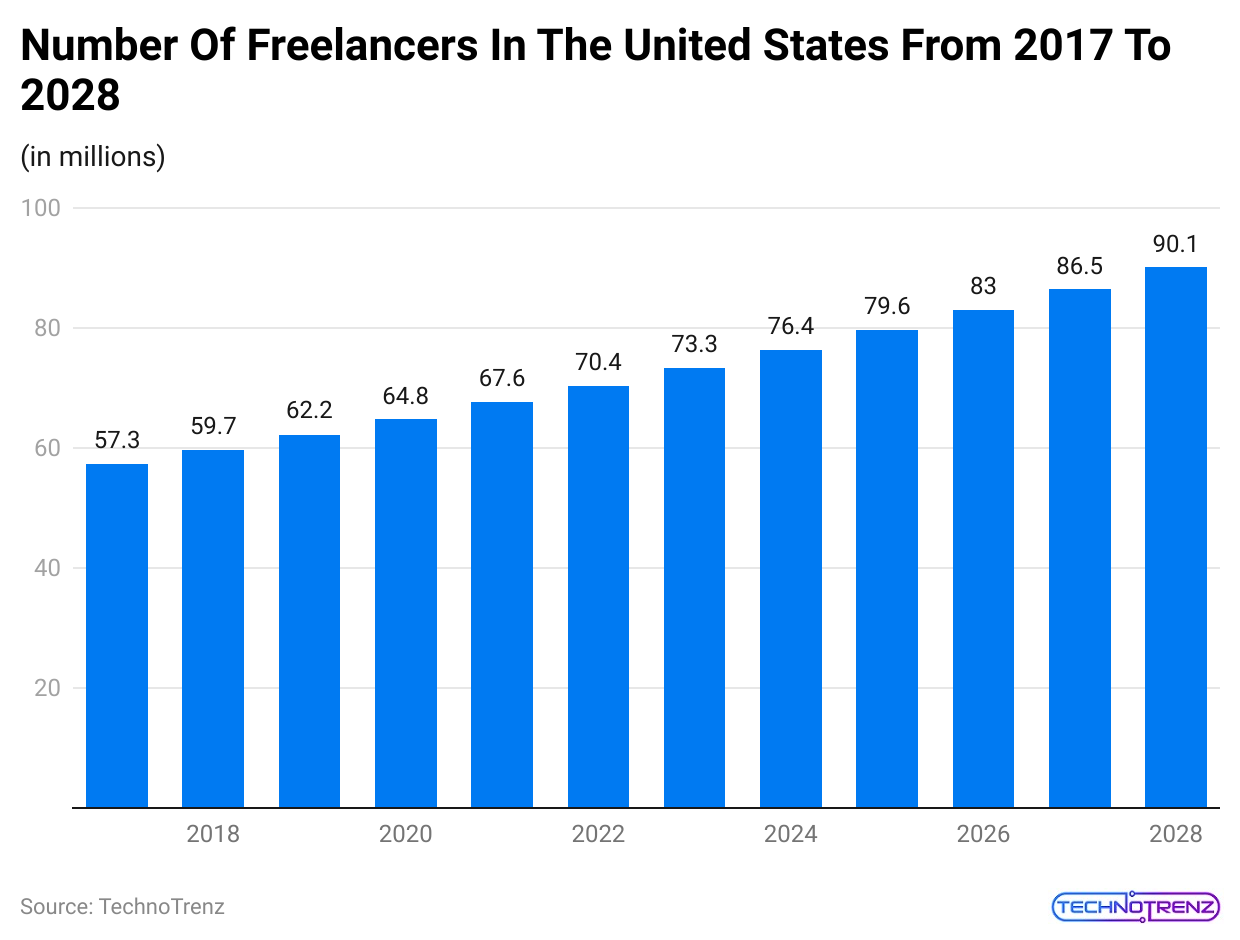
(Reference: statista.com)
| Year | Number of Freelancer in millions |
|
2017 |
57.3 |
| 2018 |
59.7 |
|
2019 |
62.2 |
| 2020 |
64.8 |
|
2021 |
67.6 |
| 2022 |
70.4 |
|
2023 |
73.3 |
| 2024 |
76.4 |
|
2025 |
79.6 |
| 2026 |
83 |
|
2027 |
86.5 |
| 2028 |
90.1 |
- This statistic tracks the count of freelancers in the US from 2017 to 2028. By 2027, there are expected to be 86.5 million freelancers, representing 50.9% of all workers in the US.
- Here’s how national income affects the rate of self-employment:
|
National Income |
Self-Employment |
|
High |
12.4% |
| Higher-Middle |
63.4% |
|
Middle |
51.4% |
| Lower-Middle |
39.6% |
|
Low |
80% |
European Freelance Statistics
- Europe has over 22 million self-employed workers, less than half the number in the US, even though Europe has more than twice the population.
- Freelancing is the fastest-growing part of the European job market.
- While traditional jobs peaked in 2000, independent work has been increasing since then.
- Greece has the highest percentage of self-employed workers in Europe, with about 30% of its workforce. Italy is second, with 22%.
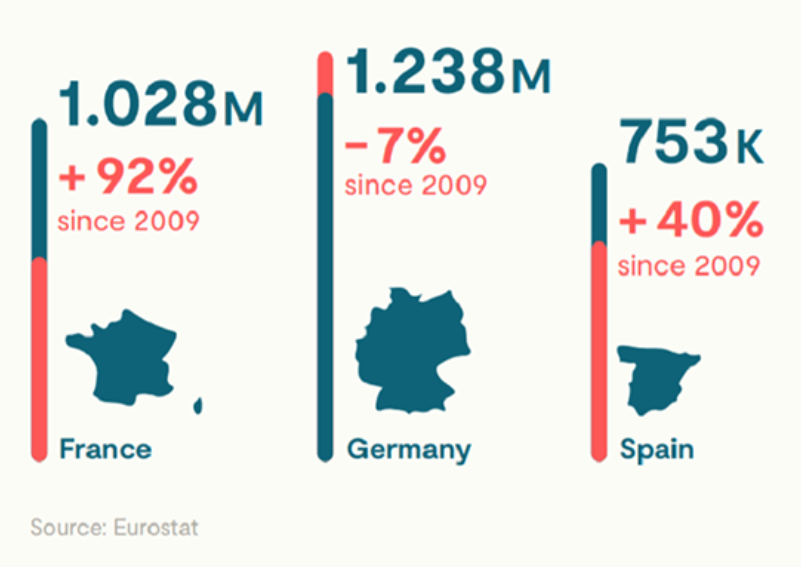
(Source: bloggingwizard.com)
- Freelance Statistics stated that Germany has around 1.24 million freelancers, which is about 2.7% of its total workforce.
- In comparison, France has about 1 million freelancers, and Spain has around 753,000.

(Source: bloggingwizard.com)
- On average, freelancers in Europe are about 40 years old. In Germany, the average age is 45; in France, it’s 37; and in Spain, it’s 40.

(Source: bloggingwizard.com)
- In Europe, there are more male freelancers than female. Men make up 65% of the freelance workforce.
- 77% of European freelancers have a bachelor’s degree or higher, and 54% have a master’s degree. This is much higher than the general population, where fewer than 40% have a university degree.
- Freelancers in Germany earn more than those in other European countries. For example, in tech and data, German freelancers make an average of €735 per day, compared to €492 in France and €230 in Spain.
- 81% of European freelancers prefer freelancing to control their schedules. The next most common reason is to make their own career decisions (76%). Many also choose to freelance for the flexibility of picking their work location (73%).
- European freelancers work an average of about 43 hours a week. This is similar to the hours worked by people in traditional jobs, showing that freelancing doesn’t necessarily mean working fewer hours.
Number Of Freelancers
- Freelance Statistics stated that currently, there are over 1.5 billion freelancers around the world.
- The percentage of self-employed people has decreased from 55.5% in 2000 to 46.6% in 2024. This drop is mainly due to more people looking for stable jobs and better opportunities.
Here are the Most Recent Numbers:
- Total Freelancers: There are 1.57 billion freelancers worldwide.
- Global Workforce: Of a global workforce of 3.38 billion, 1.57 billion are self-employed. This means that about 46.7% of workers globally are freelancers.
| Year | % of employees that freelancers |
|
1991 |
55.2% |
| 1999 |
55.7% |
|
2000 |
55.5% |
| 2005 |
53.9% |
|
2010 |
51.6% |
| 2015 |
48.2% |
|
2021 |
47.0% |
| 2024 |
46.7% |
- In 2023, there were 73.3 million freelancers in the United States. This number is expected to rise to 76.4 million by 2024, which is an increase of 3 million.
- By 2027, the number of freelancers in the United States is predicted to be 90.1 million.
- This fast increase is because of the flexibility and other benefits that come with remote work.
- The table below shows the number of freelancers in the US over the years.
|
Year |
Number of freelance workers in the United States. | Change over the previous year. |
| 2019 | 62.2 million |
2.5 million |
|
2020 |
64.8 million | 2.6 million |
| 2021 | 67.6 million |
2.8 million |
|
2022 |
70.4 million | 2.8 million |
| 2023 | 73.3 million |
2.9 million |
|
2024* |
76.4 million | 3.1 million |
| 2025* | 79.6 million |
3.2 million |
|
2026* |
83 million | 3.4 million |
| 2027* | 86.5 million |
3.5 million |
|
2028* |
90.1 million |
3.6 million |
Impact Of COVID-19 On Freelance Work
- The COVID-19 pandemic tested how well the freelance industry could handle challenges.
- In the beginning, the situation was tough as businesses quickly moved to digital solutions to follow social distancing rules. As companies adjusted, freelancers began to recover their lost income.
- The pandemic proved that freelancing is effective. As workers stayed at home, businesses had to hire freelancers for remote work.
- 94% of hiring managers started using remote workers.
- Freelance Statistics stated that almost 56% found that remote work performed better than they expected.
- 62% believe their teams will be more remote than before the pandemic.
- The pandemic highlighted the need for professionals to have more control over their work choices, including who they work with, the kind of work they do, and how much they earn.
- The rapid growth of digital technology across different fields is helping drive this change.
The pandemic made about 80 million Americans work from home, and many who tried it for the first time found they liked it:
- 24% of these new remote workers would prefer to continue working from home, even when asked to return to their offices.
- Freelance job postings increased by 41% in the second quarter of 2020 due to the pandemic.
- 73% of freelancers have not changed their rates because of the COVID-19 pandemic.
Here’s How Freelancers Are Experiencing Changes:
- 63% said the demand for their services has dropped a lot.
- 79% reported a slight decrease in demand.
- 85% said the demand for their services has stayed the same.
- 43% saw a small increase in demand.
- 30% experienced a significant increase in demand.
- Almost 75% said their hourly rates have stayed the same.
- 74% of freelancers who manage teams said they need to reduce their team sizes.
- Freelance Statistics stated that almost 83% of freelancers managing teams said they are not lowering their team’s pay.
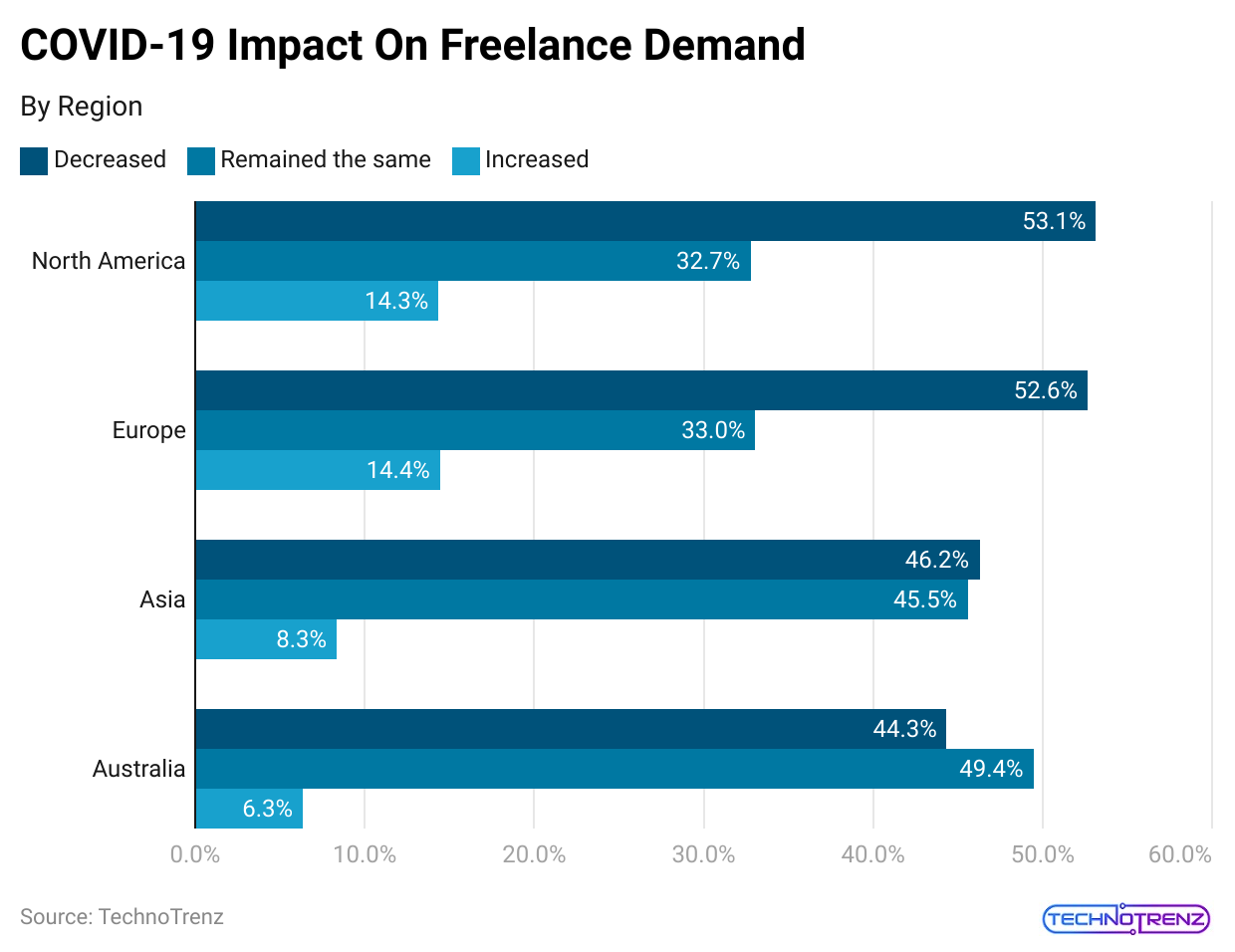
(Reference: financesonline.com)
| Decreased | Remained the same | Increased | |
|
North America |
53.1% | 32.7% | 14.3% |
| Europe | 52.6% | 33% |
14.4% |
|
Asia |
46.2% | 45.5% | 8.3% |
| Australia | 44.3% | 49.4% |
6.3% |
- Here’s how freelancers and non-freelancers compare on various concerns:
- 72% of freelancers are worried about an economic downturn in the next few years, while 81% of non-freelancers share this concern.
- 70% of freelancers are anxious about saving enough money, compared to 77% of non-freelancers.
- 68% of freelancers are concerned about retirement and saving, compared to 76% of non-freelancers.
- 67% of freelancers are worried about getting paid a fair rate, while 69% of non-freelancers feel the same way.
- 65% of freelancers are concerned about finding affordable healthcare, compared to 72% of non-freelancers.
- 64% of freelancers worry about high taxes, while 74% of non-freelancers are worried about this.
- 62% of freelancers are anxious about finding work, compared to 57% of non-freelancers.
- According to Freelance Statistics, 61% of freelancers are concerned about debt, whereas 64% of non-freelancers have this concern.
- 60% of both freelancers and non-freelancers worry about not being able to buy the things they need.
Freelancer Statistics For Business And Economy
- Freelancers contribute about $455 billion to the US economy. This number has increased by over $100 billion in recent years, and as more people start freelancing, this contribution is expected to keep growing.
- Globally, freelancers are estimated to add between $25 trillion and $60 trillion to the economy. Based on current data, we estimate their contribution to be around $56 trillion.
- Employers often hire freelancers because they can finish projects more quickly. This might be because it’s generally faster to hire a freelancer directly than to go through a staffing agency.
- Hiring freelancers is often cheaper for employers. They don’t have to pay for benefits like health insurance, paid time off, or training.
- Freelancers are hired for specific projects, so companies only pay for the work they need.
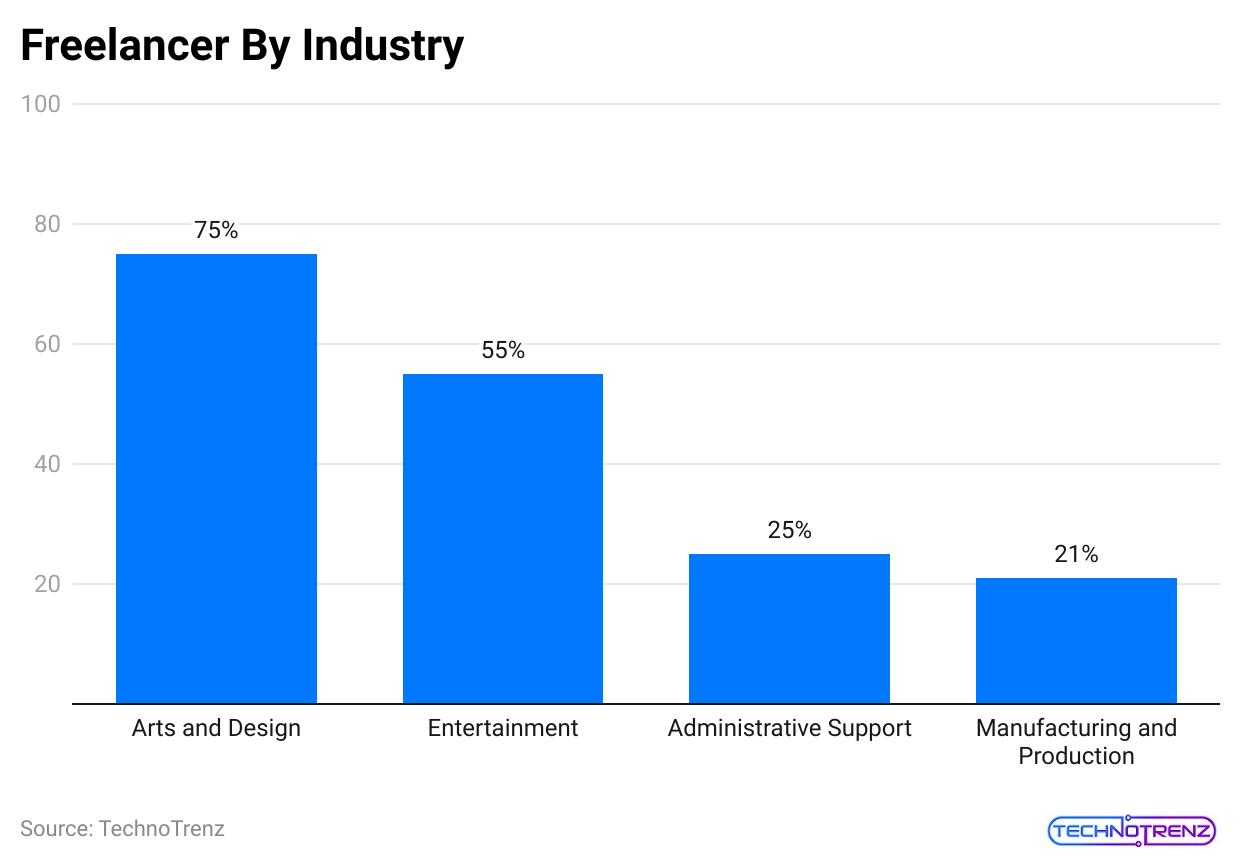
(Reference: zippia.com)
- Companies sometimes need skills that their current employees don’t have. Hiring a full-time worker for a short-term project can be costly and time-consuming.
- Freelancers provide a way to get the skills needed for a specific task quickly.
- Many hiring managers consider freelancers a better choice than staffing agency workers. They feel that staffing agencies are slow and expensive and that freelancers are more qualified and committed.
- Employers can save money by hiring freelancers because they don’t have to pay for things like holiday pay, health insurance, or sick leave.
- Traditional employees often require these additional costs.
- Companies can find and hire freelancers faster than going through staffing agencies.
- Freelancers can often be hired in about three days, while staffing agencies may take 20 days or more.
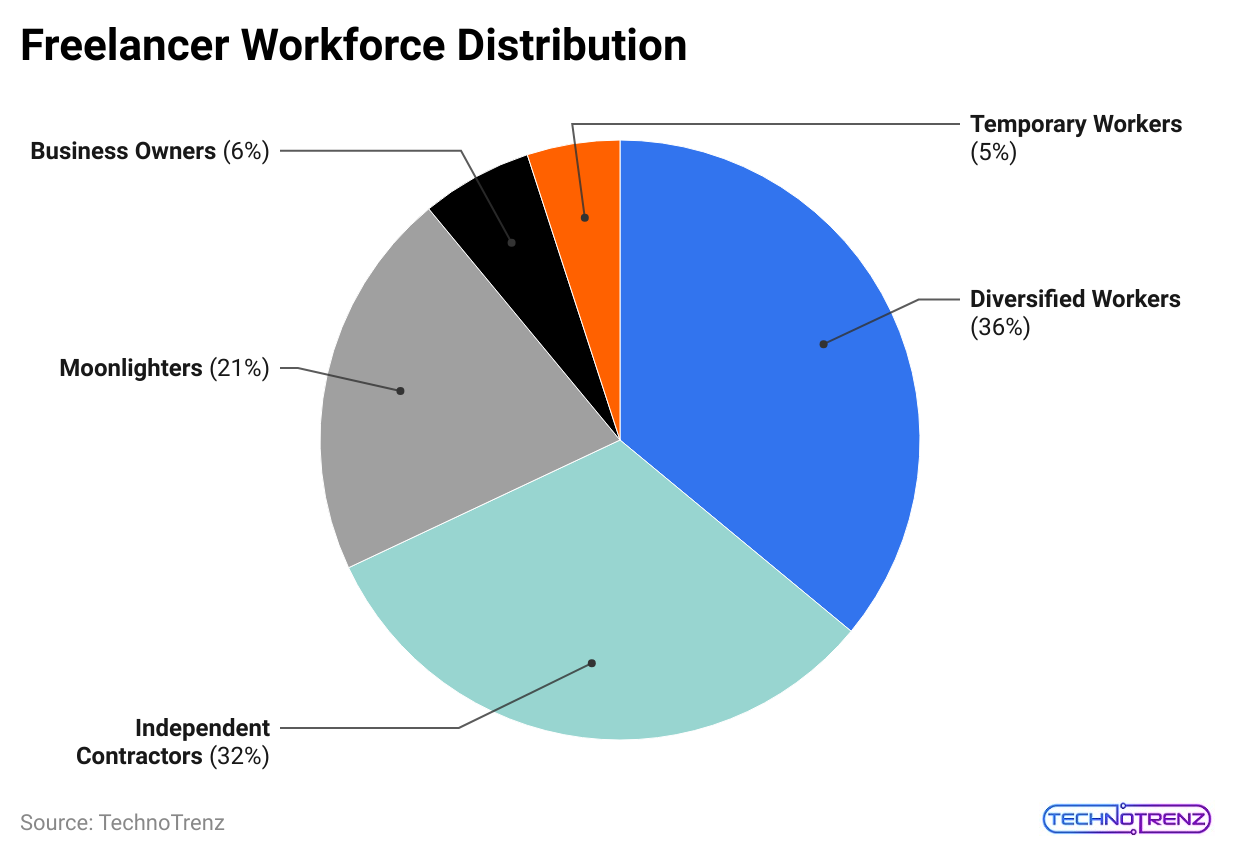
(Reference: zippia.com)
- Freelancing helps provide job opportunities for people with health conditions that limit their ability to work in traditional jobs. It supports inclusivity and offers more options for these workers without needing major changes in the business.
- Surveys show that about 78% of companies plan to use freelancers in 2023. This is beneficial for both workers, who want more flexible schedules, and employers, who enjoy lower costs and faster project completion.
- As technology and automation continue to advance, workers need to keep updating their skills.
- With better education and training, businesses will likely be able to find employees with the right skills in the next 3-5 years.
- During the pandemic, many small and medium-sized businesses began using freelancers. About 80% of these businesses plan to continue hiring freelancers shortly.
- After significant layoffs in the tech industry in 2023, many skilled tech workers turned to freelancing. This trend is expected to continue, with a noticeable increase in tech job postings.
- With the rise of AI tools like ChatGPT and Dall-E, the number of freelance jobs involving these technologies has increased dramatically.
- Since January 2023, platforms like Freelancer.com have seen a 268% rise in these types of jobs.
Freelancing Demographics Statistics
- In the US, about 75% of people working in the arts and design are freelancers.
- In comparison, only 19% of office workers and administrative support staff work as freelancers.
- In the US, 50% of Gen Z (18 to 22 years old) are freelancers. This percentage goes down as you move to older generations, with only 26% of baby boomers (55 and older) working as freelancers.
| Generation | The proportion of People Who Have Freelanced in the Last Year |
|
Baby Boomers (55+ yo) |
26% |
| Gen X (39-54 yo) |
30% |
|
Millennial (23-38 yo) |
44% |
| Gen Z (18-22 yo) |
50% |
- Among those earning money through freelancing, the youngest group (18-29 years old) stands out:
- 9% are currently freelancing
- 13% freelanced in the past year but are not freelancing right now
- 9% freelanced more than a year ago
|
Age |
Currently Freelancing | Freelanced in Last Year | Freelanced Over a Year Ago |
Combined |
|
65+ yo |
1% | 1% | 4% | 6% |
| 50 to 64 yo | 3% | 4% | 6% |
13% |
|
30 to 49 yo |
4% | 6% | 8% | 18% |
| 18 to 29 yo | 9% | 13% | 9% |
31% |
- Statistically, Hispanic people are more than four times more likely to be freelancing compared to others.
- If you’re Hispanic, you’re also about twice as likely to freelance compared to Black or Asian individuals.
- Here’s a look at the percentage of freelancers by race in the US:
|
Race |
Currently Freelancing | Freelanced in Last Year | Freelanced Over a Year Ago |
Combined |
|
White |
2% | 4% | 6% | 12% |
|
Asian |
4% | 8% | 6% | 18% |
| Black | 5% | 6% | 9% |
20% |
|
Hispanic |
9% | 11% | 10% |
30% |
- The differences in freelancing rates between men and women are much smaller compared to the differences based on age or race.
|
Gender |
Currently Freelancing | Freelanced in Last Year | Freelanced Over a Year Ago |
Combined |
|
Women |
4% | 6% | 7% | 17% |
| Men | 4% | 5% | 6% |
15% |
- Over half of US postgraduates (51%) work as freelancers, a 6% increase from 2019. This rate is at least 16% higher than that for any other education level.
- In comparison, only 31% of Americans who have only completed high school are freelancers.
- Here’s how different education levels impact the chances of freelancing:
| Highest Education Level | Proportion of Freelancers |
| Postgraduate degree | 31% |
| Bachelor’s degree |
35% |
|
Some college or associate degree |
35% |
| High school graduate or less |
51% |
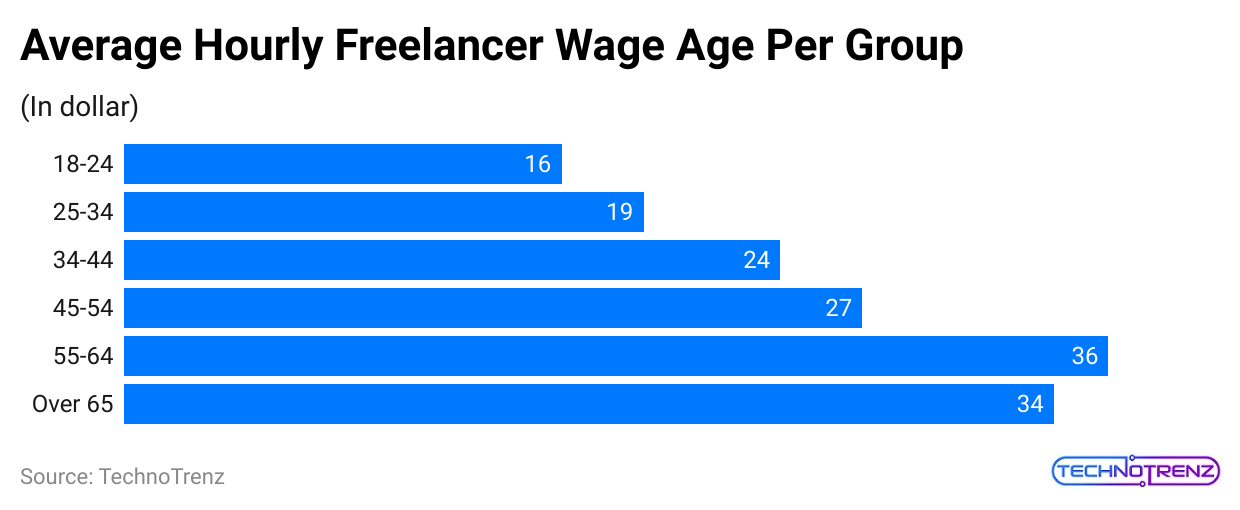 (Reference: explodingtopics.com)
(Reference: explodingtopics.com)
| Freelancer Age | Average hourly wage |
|
18-24 |
$16 |
| 25-34 |
$19 |
|
34-44 |
$24 |
| 45-54 |
$27 |
|
55-64 |
$36 |
| Over 65 |
$34 |
Freelance Platform Statistics
Upwork
- Upwork is one of the top platforms for freelancers, with over 18 million users. This makes it a leading choice for connecting freelancers and clients.
- Freelancers from the US contributed the most to Upwork’s revenue, generating $86.9 million.
- This is more than freelancers from India, who bring in $45.8 million, and the Philippines, with $39.9 million.
- This difference is partly because US freelancers generally earn more.
- Upwork’s revenue grew by 23% from the previous year, reaching $566 million.
- This increase is mostly due to a rise in the cost of “connects” (tokens needed to apply for projects) rather than a significant rise in earnings from freelancers and clients, as per Freelance Statistics.
- Upwork experienced a net loss of $89.9 million, up 60% from last year.
Fiverr
- Fiverr had a successful year in 2022, with revenue rising by 13% to a total of $337.4 million.
- Fiverr expects its revenue to grow by 4% to 8% in 2023, bringing its total revenue to between $350 million and $365 million.
- Fiverr has a large active user base, with 4.3 million buyers. This is much higher than Upwork, which has around 814,000 active buyers.
- The average budget for Fiverr clients is much lower compared to Upwork, as per Freelance Statistics.
- While Upwork clients typically spend about $5,000, Fiverr clients spend an average of $262.
- This likely reflects the types of clients each platform attracts, with Fiverr appealing more to small businesses and individuals.
- Fiverr is the most visited freelance website, with about 66 million visitors each month. Upwork has 50 million visits per month, and Freelancer.com has around 6.9 million.
Freelancer.com
- Freelancer. com has grown from 38 million users before the pandemic to over 50 million today.
- The majority of Freelancer.com users are male, with 63.62% identifying as such. Additionally, about 82% of the platform’s users are under 44 years old.
- With economic slowdowns and tech layoffs, businesses have cut back on paid advertising. However, traditional marketing, such as flyer design and packaging, has seen a 30% increase in projects.
- Freelance platforms regularly add new skills and job categories as per Freelance Statistics.
- Recent additions include language-learning AIs like ChatGPT and AI-image generators such as Dall-E and Midjourney.
| Job Category | Per Year Earnings |
|
Website Development – WordPress, PHP, HTML, MySQL |
$63,586 – $141,923 |
| Mobile App Development –
iOS, Android |
$56,493 – $145,200 |
|
Coding – HTML, Java, PHP, CSS, Backend |
$101,250 – $219,108 |
| Game Development –
Game Design, Unity |
$56,493 – $258,501 |
|
Design – UX Design, Illustrator, Website Design, Photoshop |
$75,789 – $263,571 |
- com’s latest research shows that the highest-paying freelance jobs are in Design, Game Development, Coding, Mobile App Development, and Website Development.
- With many tech jobs being cut recently, more people are likely to compete for these positions.
Conclusion
Freelancing is now a major part of the global job market, thanks to the rise of remote work. Freelancing allows people to work from anywhere and often offers a cost-effective solution for companies needing IT help. The ongoing digital changes in companies worldwide will help the freelance industry grow.
As businesses update how they operate, they’ll start using more freelancers to get the job done. Freelancers also enjoy great benefits, like having control over their work and schedule. I hope you found this article” Freelance Statistics” helpful.
Sources
FAQ.
Sairaj, the richest freelancer in India, inspires many people who want to leave traditional jobs and pursue success independently.
Creative Projects: Agencies often bring in freelancers for tasks such as graphic design, writing, video production, and other creative jobs.
Campaigns: Freelancers can be hired for specific marketing campaigns or to help with additional work.

Saisuman is a professional content writer specializing in health, law, and space-related articles. Her experience includes designing featured articles for websites and newsletters, as well as conducting detailed research for medical professionals and researchers. Passionate about languages since childhood, Saisuman can read, write, and speak in five different languages. Her love for languages and reading inspired her to pursue a career in writing. Saisuman holds a Master's in Business Administration with a focus on Human Resources and has worked in a Human Resources firm for a year. She was previously associated with a French international company. In addition to writing, Saisuman enjoys traveling and singing classical songs in her leisure time.


